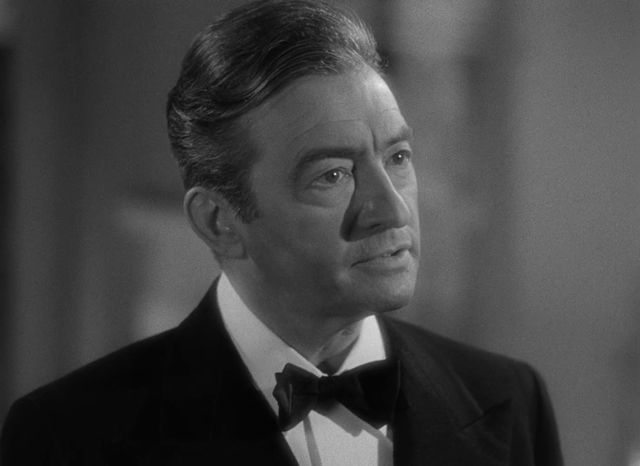REVIEW : "Notorious" (1946) - Movie by Alfred Hitchcock

Ingrid Bergman supposedly was one of Hitchcock´s favourite female leads ("blondes"). And I can understand why. Personally, of all the "classic" female movie stars of this era, swedish Ingrid Bergman, is my favourite. Not because her acting is particularly deep in a modern sense or because of her beauty, of which she obviously had a lot. No, it is because when I watch her I actually feel like there is a person behind the face. Her beauty is more natural and fresh than your average Hollywood starlet. The key to her success and, I presume, her swedish predecessor, Greta Garbo, was this slightly exotic, slightly imperfect, tall and slender scandinavian look, that has a magnetic appeal on the silver screen.
The same cannot be said to be the case of Cary Grant. My god, I don't like him and never did. He is the stiffest of the stiffest, cookie cutter, square-jawed handsome, movie star. He plays the same one-dimensional "jet-set" style loverboy he always does. He is particularly cast to fit this stereotypical role, because that is what he is good for. Granted I have not seen nearly all of his movies .. as I avoid them ... but I bet ya, he is the same character in every single one of them. That Grant is in this movie already lowers my score 1 or 2 points.


The plot here is a very contrived, post WW2 spy one, that really is not worth dwelling on. Personally I am not very focused on plots, unless it is a very integral part of the story creation, but this one is outright ridiculous. Nevermind, we get to fly to Rio de Janeiro with our two attractive leads and get a LOT of kissing and hugging.
To be honest, overall it feels like two movies glued together, but not in a way that makes them work together, at least not sufficiently for it to be engaging. Or maybe I should say, the romantic one, is not engaging for reasons I have already mentioned. but it only makes it even more misplaced, having to compete with a pretty decent, suspenseful third act.


My feeling is that this movie is mostly revered because of the coupling of the two actors and them being who they are. It cannot possibly be for the plot or the story. It takes about halfway through before the tension rises sufficiently to ignite interest and only somewhere in the third act, the suspense is of a caliber, that is worthy of Hitchcock.
But when he "shows", Hitchcock is a master of composition, movement, editing and everything else. The reason to watch this one is mainly because of some brilliant directing and camerawork.


The cinematography is at times very daring and creative. Far beyond what most other directors would even dream of trying. Watch the shot when the coffee cup is entered out of focus while Bergman and Reins converse. The cup is the essential character as it is the one with the poison in it, but Bergman does not understand that yet.
Another and more famous one is the crane shot from under the ceiling down to show Bergman´s hand holding a key. When cinephiles look for specific shots in a movie, long crane or tracking shots are usually high on the hit-list. This one is more "relaxed" than the one in "Young and innocent" from 1937, where he basically traverses a whole ballroom to zoom in on a drummers twitching eyes.


Early on there is a scene where Grant wakes up Bergman who is hung over and we see Grant through her eyes lying down and dizzy. This way Grant slowly turns around clockwise in the frame as he walks past her and she turns her head in sync with his movement. Certainly a scene that was deliberately chosen for its "expressionist feel and not for its necessity to tell the story, which is how any ordinary director would have tackled it.
Lastly a significant shot (or scene) is the final montage when Grant "helps" Bergman down the stairs in a suspenseful switch between five or six camera angles between good guys and bad guys, while a dialogue is carried out. This is in my opinion one of the most important aspects from a cinephilistic view, as it certainly echoes what would later become the famous "shower scene" in Psycho 15 years later.

Overall the latter part of the movie is worth investing time on and mostly because of the cohesive cinematography and directing style and technique used. I certainly feel like Hitchcock made this more out of duty than interest but managed to sneak in a lot of interesting cinematography nonetheless. On its surface it is a harmless romantic thriller, while underneath there are the beginnings of what would later come and traces back to the likes of Rebecca, in the way the antagonists mother is similar to that of Mrs. Danvers. Hitchcock must be somewhat recommended for being able to squeeze out a decent thriller of a plot basically about stealing a key and getting into a wine cellar.
It might also be in its place to point out that Claude Rains does a decent job of the antagonist and brings him a more facetted feel than other actors are capable of (Cary Grant). He reminds me mostly of Bruno in Strangers On A Train as he has the same kind of switch between looking a gentleman and having a psychotic streak.
I will give this one a (small) recommendation for cinephiles, the Bergman and the Grant fans, but closer to a not recommended for the average viewer. You can certainly live without it.
6/10